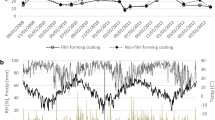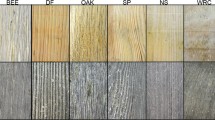Abstract
To prevent the degradation of outdoor wood products such as wood decks, it is vital to keep them dry. Weathering induces checks on wood surfaces. Surface checks gather water and maintain a high moisture content, causing decay of the wood. Herein, water absorption and redrying tests were performed on wood specimens with slits and simulated surface checks, and the moisture content distribution on a cross section was obtained using X-ray densitometry. On redrying of the slit, two levels of slit depths (10 and 20 mm) were tested under four redrying conditions: three humidity levels with no airflow and a medium humidity level with a wind velocity of 1 m/s. The redrying rate and moisture trapping time that kept moisture content greater than 20% were used to estimate the moisture trapping risk in the surface check. The moisture trapping risk was found in the no-wind condition until 48 h redrying or longer, independent of the slit depth. Conversely, in the forced-air condition, an air-dried state was observed within 24 h. The redrying rate in the 10 mm depth slit was influenced by ambient humidity levels; however, the redrying rate in the 20 mm depth slit was unaffected. Overall, while a deeper check has a higher risk of moisture trapping, if the wood is in a poorly ventilated environment with a high ambient humidity level, a shallow check with a 10 mm depth may also be at risk.









Similar content being viewed by others
References
Bornemann T, Brischke C, Alfredsen G (2014) Decay of wooden commodities—moisture risk analysis, service life prediction and performance assessment in the field. Wood Mater Sci Eng 9:144–155. https://doi.org/10.1080/17480272.2014.904431
Brischke C, Meyer-Veltrup L (2015) Moisture content and decay of differently sized wooden components during 5 years of outdoor exposure. Eur J Wood Prod 73:719–728. https://doi.org/10.1007/s00107-015-0960-7
Brischke C, Rolf-Kiela H (2010) Durability of European oak (Quercus spp.) in ground contact—a case study on fence posts in service. Eur J Wood Prod 68:129–137. https://doi.org/10.1007/s00107-009-0364-7
Brischke C, Meyer-Veltrup L, Bornemann T (2017) Moisture performance and durability of wooden façades and decking during six years of outdoor exposure. J Build Eng 13:207–215. https://doi.org/10.1016/j.jobe.2017.08.004
CEN (1994) EN 460 Durability of wood and wood-based products—natural durability of solid wood—guide to the durability requirements for wood to be used in hazard classes, European Committee for Standardization, Geneva
De Groot RC (1992) Test assemblies for monitoring decay in wood exposed above ground. Int Biodeterior Biodegrad 29:151–175. https://doi.org/10.1016/0964-8305(92)90014-F
Dvinskikh SV, Furó I, Sandberg D, Söderström O (2011) Moisture content profiles and uptake kinetics in wood cladding materials evaluated by a portable nuclear magnetic resonance spectrometer. Wood Mater Sci Eng 6:119–127. https://doi.org/10.1080/17480272.2010.543288
Flæte PO, Høibø OA, Fjærtoft F, Nilsen TN (2000) Crack formation in unfinished siding of aspen (Populus tremula L.) and Norway spruce (Picea abies (L.) Karst.) during accelerated weathering. Holz Roh Werkst 58:135–139. https://doi.org/10.1007/s001070050404
Fredriksson M, Wadsö L, Johansson P, Ulvcrona T (2016) Microclimate and moisture content profile measurements in rain exposed Norway spruce (Picea abies (L.) Karst.) joints. Wood Mater Sci Eng 11:189–200. https://doi.org/10.1080/17480272.2014.965742
Gellerich A, Brischke C, Emmerich L, Meyer-veltrup L, Kaudewitz, P (2017) Evaluation of surface cracks on wood—physical assessment versus subjective sensation evaluation of surface cracks on wood—physical assessment versus subjective sensation. In: IRG Annual Meeting. Ghent, Belgium, IRG/WP 17-20617
Isaksson T, Thelandersson S, Jermer J, Brischke C (2015) Service life of wood in outdoor above ground applications : Engineering design guideline. Lund University, Lund, TVBK-3067
JISC (2009) JIS Z 2101 Methods of test for wood. In: Japanese Industrial Standards Committee, Tokyo (in Japanese)
JISC (2019) JIS A 1475 method of test for hygroscopic sorption properties of building materials. In: Japanese Industrial Standards Committee, Tokyo (in Japanese)
Keržič E, Humar M (2021) Studies on the material resistance and moisture dynamics of wood after artificial and natural weathering. Wood Mater Sci Eng 2021:1–7. https://doi.org/10.1080/17480272.2021.1902388
Kržišnik D, Lesar B, Thaler N, Planinšič J, Humar M (2020) A study on the moisture performance of wood determined in laboratory and field trials. Eur J Wood Prod 78:219–235. https://doi.org/10.1007/s00107-020-01506-z
National Astronomical Observatory of Japan (2019) Rika-nenpyo (Chronological science tables). Maruzen Publishing Co., Ltd., Tokyo, pp 224–225 (in Japanese)
Niklewski J, Brischke C, Frühwald Hansson E, Meyer-Veltrup L (2018) Moisture behavior of weathered wood surfaces during cyclic wetting: measurements and modeling. Wood Sci Technol 52:1431–1450. https://doi.org/10.1007/s00226-018-1044-8
Osawa T, Maeda K, Shida S (2018) Effect of water absorption from surface checks on the moisture retention in wood deck exposed outdoor. Mokuzaihozon Wood Protect 44:67–80. https://doi.org/10.5990/jwpa.44.67 (in Japanese with English abstract)
Osawa T, Maeda K, Tsunetsugu Y, Shida S (2019) Influence of surface checks on wood moisture content during wetting and re-drying. Eur J Wood Prod 77:681–689. https://doi.org/10.1007/s00107-019-01423-w
Osawa T (2018) Uddo-dekki no hyoumen-sonshou ga mizunure-ji no suibunteitai ni oyobosu eikyou (Influence of surface damages on moisture trapping in wooden decks during wetting and re‑drying). Dissertation, The University of Tokyo. https://doi.org/10.15083/0002002293 (in Japanese with English figure and table)
Perré P, Turner I (2007) Coupled heat and mass transfer. In: Perré P (ed) Fundamentals of wood drying. A.R.BO.LOR., Nancy, pp 203–241
Salin J-G (2007) External heat and mass transfer. In: Perré P (ed) Fundamentals of wood drying. A.R.BO.LOR., Nancy, pp 175–201
Sandberg K (2008) Degradation of Norway spruce (Picea abies) heartwood and sapwood during 5.5 years’ above-ground exposure. Wood Mater Sci Eng 3:83–93. https://doi.org/10.1080/17480270902774886
Sandberg D, Söderström O (2006) Crack formation due to weathering of radial and tangential sections of pine and spruce. Wood Mater Sci Eng 1:12–20. https://doi.org/10.1080/17480270600644407
Schmidt O (2006) Wood and tree fungi; biology, damage, protection, and use. Springer, Berlin, Heidelberg, pp 60–67
Siau JF (1971) Flow in wood, 1st edn. Syracuse University Press, New York, pp 15–34
Stirling R, Morris PI (2015) Factors affecting performance of preserved wood decking against decay fungi. In: IRG Annual Meeting. Viña del Mar, Chile, IRG/WP 15-30663
Ueda M (2014) Shitsudo-to-jouhatsu (humidity and evaporation), 4th edn. Corona publishing co. Ltd, Tokyo, pp 83–137 (in Japanese)
Wadsö L (1993) Surface mass transfer coefficients for wood. Dry Technol 11:1227–1249. https://doi.org/10.1080/07373939308916897
Watanabe K, Saito Y, Avramidis S, Shida S (2008) Non-destructive measurement of moisture distribution in wood during drying using digital X-ray microscopy. Dry Technol 26:590–595. https://doi.org/10.1080/07373930801944796
Yamamoto K (1985) Decay factors of wooden windowframes in schoolhouses. Mokuzaihozon (wood Protect) 11:97–102. https://doi.org/10.5990/jwpa.11.97 (in Japanese with English abstract)
Author information
Authors and Affiliations
Corresponding author
Ethics declarations
Conflict of interest
On behalf of all authors, the corresponding author states that there is no conflict of interest.
Additional information
Publisher's Note
Springer Nature remains neutral with regard to jurisdictional claims in published maps and institutional affiliations.
Supplementary Information
Below is the link to the electronic supplementary material.
Rights and permissions
Springer Nature or its licensor holds exclusive rights to this article under a publishing agreement with the author(s) or other rightsholder(s); author self-archiving of the accepted manuscript version of this article is solely governed by the terms of such publishing agreement and applicable law.
About this article
Cite this article
Osawa, T., Maeda, K. & Tsunetsugu, Y. Influence of check depth, redrying conditions of various ambient humidities, and the presence or absence of airflow on moisture trapping in surface checks of wood. Eur. J. Wood Prod. 81, 329–341 (2023). https://doi.org/10.1007/s00107-022-01851-1
Received:
Accepted:
Published:
Issue Date:
DOI: https://doi.org/10.1007/s00107-022-01851-1




